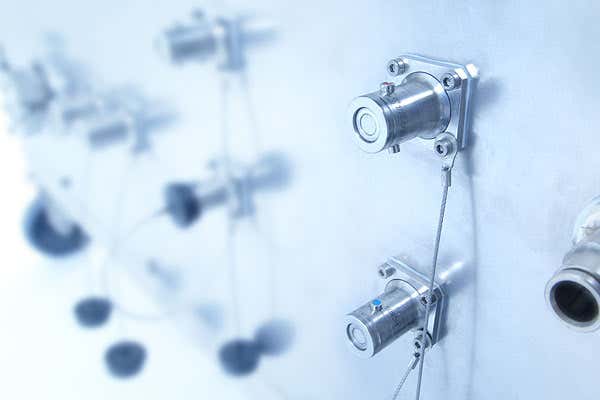Overview
An integrated solution that combines a robust laser diffraction particle sizing sensor with fully automated concentration control to deliver continuous on-line (or manual at- or off-line) wet measurement of particulates in continuous or batch processes. This option is used for more concentrated solid-liquid and liquid-liquid streams, with sample dilution closely and automatically controlled via both a pre-diluter and a cascade diluter:
- Uniform, highly polished surfaces to avoid particle build-up; designed for ease of cleaning.
- Base model hardware manufactured to GAMP5 standards and compatible with CIP/SIP requirements to meet specific manufacturing specifications. Options for validation and 21 CFR part 11.
- Easy-to-use software and fully automated operation to minimize training requirements and release operator time.
- Integration with existing control platforms to simplify development of automated control protocols.
- High reliability of > 95% with little downtime, minimal maintenance and maximum ROI.
- Intrinsically safe version available for hazardous zoned environments.
How it works
Overview
The Insitec wet system with fully automated concentration control integrates sample dilution hardware with a robust laser diffraction particle sizing sensor. Both elements of the system are tailored to meet the requirements of the specific application, which might range from a simple off-line, manually-fed system to a fully automated, validated on-line solution for continuous monitoring and multivariate control.
Sample dilution
For accurate laser diffraction analysis light must be able to penetrate through the sample, a limitation that imposes an absolute upper concentration limit for measurement. Multiple scattering, where the laser light interacts with more than one particle prior to detection can also be an issue. Sample dilution is therefore an essential element of analysis for more concentrated liquid-liquid or solid-liquid streams.
In this system a pre-diluter and cascade diluter work in tandem to representatively reduce the concentration of the sample to an optimum level while at the same time avoiding dilution shock. Dilution shock is where the sample is irreversibly altered by decreasing concentration too rapidly.
For on-line applications, representative sampling of the process stream is achieved using a cross-cut sampling valve (choice of sample cuts from 0.98, 1.4, 1.9 and 2.5 cc) with pneumatic actuator and electrical control solenoid. Flow through the sample loop is continuous, eliminating a potential time-lag in the system and reducing the likelihood of blockages. All wetted parts are 316SS and PTFE.
For at- and off-line applications the sample is manually introduced into the dilution system.
The pre-diluter is a glass chamber with pneumatic stirrer and level sensors for dilution volume control. The cascade diluter is a diluent driven patented design based on a coaxial venturi in which dilution ratio is controlled by the number of stages and the dimensions of internal flow nozzles. Both units are self-cleaning with minimal moving parts and are fully automated.
Design of the dilution system is optimized to minimize diluent usage while at the same time achieving a suitable concentration for measurement. The diluent used is typically water and preferably recycled into the process to minimize waste.
Sample Measurement
All Insitec systems use the technique of laser diffraction to rapidly measure particle size and employ patented multiple scattering algorithms to extend the working concentration range of the technique. These algorithms mathematically correct for the concentration-dependent effect of multiple scattering reducing sample dilution requirements to a minimum and ensuring that all measurements are robustly independent of sample concentration.
In this fully automated solution the sensor is selected to meet the requirements of the application with options for, for example, intrinsically safe operation. All sensors are capable of measuring complete particle size distributions in less than 1 second. Working alongside the dilution hardware they produce reliable, timely and complete data, reporting full particle size distributions. These data provide a secure foundation for better process control whether that control is manual or automated.
Data presentation and use
Insitec systems are integrated within the process plant. Typically they are operated from a centralized control room and the measurement results drive routine decision making. Powerful software packages make integration and data interpretation straightforward.
Malvern Link II software provides the functionality required to integrate an Insitec within the existing control system and to automate process control. It allows operation of the analyzer, including all dilution hardware, from either a dedicated PC or from existing control mimics. Importantly Malvern Link II is not confined only to Insitec integration. This software also eases integration with other instrument types, simplifying multivariate control.
RTSizer software presents the measurement data in a clear and accessible way. Results reporting can be tailored to industry and customer norms to improve information flow. Insitec data are used to:
- Improve process understanding.
- Deliver instant upset detection.
- Support comprehensive process optimization.
- Automate process control.
Because complete particle size distributions are reported, monitoring and control can be based on whichever size fraction is of interest; the fines, the 3 to 30 micron fraction, the amount of material over 200 microns, for example. Insitec data drive optimized manual control strategies and enable the full automation of process control, delivering substantial economic returns.
Specification
System
| Measurement type | Particle size |
|---|---|
| Measurement range | 0.1 to 2500µm |
| Measurement principle | Laser diffraction |
| Optical models | Mie theory |
| Accuracy | ±2% on Dv(50) reported using the verification reticle |
General
| Power | 100/240V |
|---|---|
| Enclosure rating | IP65 |
| Operating platforms | 10 bar (g) |
| Software | RTSizer (for instrument control) Malvern Link II (for system automation and data link) |
| Maximum distance from instrument to PC | 500m (up to 2 km using fiber optics) |
Operating environment
| Temperature | 10°C – 70°C |
|---|---|
| Humidity | 35% - 80% (non-condensing) |

